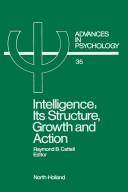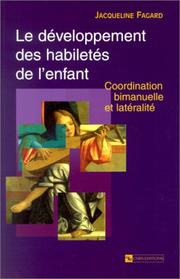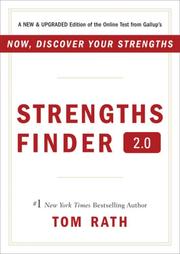| Listing 1 - 7 of 7 |
Sort by
|
Book
Year: 2019 Publisher: Colombia : Editorial Uniagustiniana,
Abstract | Keywords | Export | Availability | Bookmark
 Loading...
Loading...Choose an application
- Reference Manager
- EndNote
- RefWorks (Direct export to RefWorks)
La formación a través de las didácticas académicas en la formación de ingenieros permite aplicar conceptos técnicos, teorías, teoremas y fórmulas de una forma diferente y agradable para los estudiantes que ven en estos ejercicios de simulación, un acercamiento a la industria real. Las didácticas académicas en la formación de ingenieros están orientadas a simular los procesos de producción, los sistemas de información, los indicadores de gestión, los modelos, las superficies de trabajo y otras actividades industriales, con un grado de complejidad acorde al avance académico de los grupos a los que particularmente van dirigidos. El objetivo principal es realizar los ejercicios, identificar y proponer mejoras a los procesos y repetir las didácticas aplicando los mejoramientos propuestos, analizando los resultados en términos de incremento de la productividad, donde se evidencie con claridad el aumento de los niveles de satisfacción de los clientes (internos – externos), se logren mejores estándares en los indicadores de gestión, se aumente la integración de los trabajadores en un entorno ergonómico más adecuado y reflejen resultados en los niveles de clima laboral.
Ability. --- Engineering --- Vocational education; Professional education --- Aptitudes. --- Formación profesional --- Ingeniería --- Teaching. --- Engineering. --- Ingeniería.

ISBN: 0444879226 9786611788452 1281788457 0080866891 9780080866895 9781281788450 9780444879226 Year: 1987 Volume: 35 Publisher: Amsterdam : Elsevier,
Abstract | Keywords | Export | Availability | Bookmark
 Loading...
Loading...Choose an application
- Reference Manager
- EndNote
- RefWorks (Direct export to RefWorks)
With essentially the same basis as the 1971 Abilities, Their Structure, Growth and Action, this new volume reflects the developments of subsequent years.
Intellect --- Ability --- Aptitude. --- Intelligence. --- Human intelligence --- Intelligence --- Mind --- Psychology --- Mental retardation --- Thought and thinking --- Abilities --- Aptitude --- Proficiency --- Skill --- Skills --- Talent --- Talents --- Expertise --- Aptitudes --- Intellect. --- Ability. --- Systèmes, Conception de --- System design --- Systèmes, Conception de
Book
ISBN: 9789027269546 9027269548 9789027242563 9027242569 1322205817 Year: 2014 Publisher: Amsterdam/Philadelphia John Benjamins Publishing Company
Abstract | Keywords | Export | Availability | Bookmark
 Loading...
Loading...Choose an application
- Reference Manager
- EndNote
- RefWorks (Direct export to RefWorks)
With increasing numbers of students wishing to become conference interpreters, but limited capacities in most university degree programs, accurate admission testing is an important means of predicting an applicant's chances of completing the program successfully. This article focuses on three aptitude tests for simultaneous interpretation: Pöchhacker's SynCloze test; Chabasse's cognitive shadowing test; and Timarová's personalized cloze test. The test battery was administered at the start of the 2009/2010 academic year to students beginning the two-year Master's program in conference interpret
Aptitudes. --- Interpreting. --- Translating and interpreting -- Study and teaching. --- Translating and interpreting --- Tolken --- Study and teaching. --- talent --- begaafdheid --- aanleg --- beroep --- aanleg. --- beroep. --- Languages & Literatures --- Philology & Linguistics --- Study and teaching --- Talent --- Begaafdheid --- Aanleg. --- Beroep. --- Interpretation and translation --- Interpreting and translating --- Language and languages --- Literature --- Translation and interpretation --- Translating --- Translators

ISBN: 2271059437 2271091373 Year: 2001 Publisher: CNRS Éditions
Abstract | Keywords | Export | Availability | Bookmark
 Loading...
Loading...Choose an application
- Reference Manager
- EndNote
- RefWorks (Direct export to RefWorks)
Les habiletés complexes que l’on peut observer chez des personnes exerçant une activité manuelle mettent en jeu les deux mains de façon complémentaire. Ces habiletés, qui se sont développées au cours de l’évolution et qui peuvent exiger une vie d’apprentissage, se mettent en place pour l’essentiel au cours de l’enfance. Le présent ouvrage lie de façon originale le thème du développement des habiletés manuelles à celui des coordinations bimanuelles. Après avoir retracé l’émergence des habiletés manuelles d’un point de vue philogénétique, puis défini les principes de base de la coordination bimanuelle et les principales contraintes qui la caractérisent, il explore les structures physiologiques concernées, en portant l’accent sur la latéralité hémisphérique et sur le corps calleux, par lequel s’opère la majorité des échanges interhémisphériques. Puis l’auteur analyse le changement avec l’âge de ces structures et de leur fonctionnement, décrit le développement des coordinations visuo-manuelles et bimanuelles, avant d’approfondir les aspects liés à la latéralité. Le dernier chapitre, enfin, rend compte des principaux cadres théoriques permettant de comprendre le développement de ces habiletés. Par son approche pluridisciplinaire – historique, psychologique, physiologique, neuro-développementale -, cet ouvrage de référence sans équivalent en langue française est susceptible de répondre aux attentes des universitaires, chercheurs et étudiants en psychologie cognitive et en psychologie du développement, mais aussi aux chercheurs et professionnels de l’éducation physique et sportive, aux psychomotriciens et aux ergonomes.
Motor ability in children. --- Cerebral dominance. --- Dominance, Cerebral --- Functional asymmetry (Brain) --- Hemispheric dominance (Brain) --- Lateralization (Brain) --- Left and right brain --- Right and left brain --- Cerebral hemispheres --- Dual-brain psychology --- Laterality --- Whole brain learning --- Motor development in children --- Child development --- Perceptual-motor learning --- Physical education for children --- développement de l'enfant --- aptitudes motrices --- performances psychomotrices --- psychomotricité --- latéralité --- enfants --- apprentissage moteur
Book
ISBN: 9782875580351 2875580353 2875580361 Year: 2012 Volume: *7 Publisher: Louvain-la-Neuve : Presses universitaires de Louvain, [2012]
Abstract | Keywords | Export | Availability | Bookmark
 Loading...
Loading...Choose an application
- Reference Manager
- EndNote
- RefWorks (Direct export to RefWorks)
L'enseignement est de moins en moins souvent la vocation de toute une vie. Nombreux sont les collègues qui ne font plus carrière à l'école et qui la quittent après une expérience très courte. L'interdisciplinarité, la collégialité, le travail collaboratif modifient profondément l'exercice de la profession. Cette évolution a des répercussions sur l'attrait du métier d'enseignant ainsi que sur la formation initiale et continue. L'éducation physique n'échappe pas à ces transformations du paysage éducatif et scolaire. En particulier, l'enseignant novice est mis à l'épreuve par les nouvelles exigences, qui questionnent d'emblée ses capacités de maîtrise du processus d'enseignement-apprentissage. Ce livre rassemble douze contributions internationales francophones qui respectent l'itinéraire chronologique des futurs professionnels : étudiants, stagiaires, novices, formation continue. Outre des thématiques comme le plaisir d'apprendre ou d'enseigner et les interactions langagières, il aborde une réflexion plus générale à propos du processus de construction d'une identité d'enseignant en éducation physique, vue en tension sous différents aspects socioprofessionnels.
Aptitude professionnelle --- Aptitudes professionnelles --- Beroepskwalificaties --- Capacité professionnelle --- Capacités professionnelles --- Competentieprofiel --- Déqualification (Sociologie du travail) --- Professional qualifications --- Professionnalisation --- Profiel competentie --- Qualification profile --- Qualifications professionnelles --- Savoir professionnel --- Savoirs professionnels --- Travailleurs -- Qualifications --- Vocational qualifications --- Physical education teachers --- Training of --- Physical education and training --- Study and teaching --- Professeurs d'éducation physique et sportive --- Identité professionnelle. --- Formation. --- Identity (Psychology) --- Sociology --- professeurs d'éducation physique et sportive --- formation --- identité professionnelle --- qualifications professionnelles --- études --- sport --- enseignement --- Professeurs d'éducation physique et sportive --- Identité professionnelle.

ISBN: 9781595620156 159562015X 1595620249 1595620761 9781595620248 9781595620767 Year: 2007 Publisher: New York Gallup Press
Abstract | Keywords | Export | Availability | Bookmark
 Loading...
Loading...Choose an application
- Reference Manager
- EndNote
- RefWorks (Direct export to RefWorks)
Do you have the opportunity to do what you do best every day? Chances are, you don't. All too often, our natural talents go untapped. From the cradle to the cubicle, we devote more time to fixing our shortcomings than to developing our strengths. To help people uncover their talents, Gallup introduced the first version of its online assessment, StrengthsFinder, in 2001 which ignited a global conversation and helped millions to discover their top five talents. In its latest national bestseller, StrengthsFinder 2.0, Gallup unveils the new and improved version of its popular assessment, language of 34 themes, and much more. While you can read this book in one sitting, you'll use it as a reference for decades. Loaded with hundreds of strategies for applying your strengths, this new book and accompanying website will change the way you look at yourself -- and the world around you -- forever.
Vaardigheden talenten zelfontwikkeling zelfontplooiing creativiteit success --- Personnalité Persoonlijkheid --- Assessment Assessment --- Executive ability --- Ability --- Performance --- 658.4092 --- 415.4 --- 366.4 --- ondernemerschap --- talenten --- leidinggeven --- Competence --- Work --- Abilities --- Aptitude --- Proficiency --- Skill --- Skills --- Talent --- Talents --- Expertise --- Administrative ability --- Executive skills --- algemene psychologie, hogere geestelijke functies (oa. leren, kennen, denken, begaafdheid, fantasie, geheugen, leerpsychologie) --- Management --- Success in business --- Conduct of life --- Personality tests --- Achievement --- Self-Assessment --- Leadership --- E-books --- Business & Economics --- Management Styles & Communication --- Ethics, Practical --- Morals --- Personal conduct --- Ethics --- Philosophical counseling --- Business --- Business failures --- Creative ability in business --- Prediction of occupational success --- Influentials --- Assessment, Self --- Self-Criticism --- Self Assessment --- Self Assessment (Psychology) --- Assessment, Self (Psychology) --- Assessments, Self --- Assessments, Self (Psychology) --- Self Assessments --- Self Assessments (Psychology) --- Self Criticism --- Self-Assessments --- Self-Criticisms --- Metacognition --- Achievements --- Academic Performance --- Aptitudes --- Character tests --- Educational tests and measurements --- Neuroses --- Personality assessment --- Psychological tests --- Diagnosis --- Accomplishment --- Accomplishments --- Developmental psychology --- Social psychology --- Personnel management --- talentmanagement --- zelfontplooiing --- loopbaanontwikkeling --- Personality tests.
Book
Year: 2022 Publisher: Basel MDPI - Multidisciplinary Digital Publishing Institute
Abstract | Keywords | Export | Availability | Bookmark
 Loading...
Loading...Choose an application
- Reference Manager
- EndNote
- RefWorks (Direct export to RefWorks)
Intelligence research is mainly concerned with basic science questions; what is the psychometric structure of intelligence? What are the cognitive bases of intelligence? What are the brain-based correlates of intelligence? What does intelligence predict? Such research is needed, but there are also problems larger than those presented in intelligence tests, including problems of today. What is the role of human intelligence in solving consequential real-world problems? Here, leading scholars in the field of intelligence each address one real-world problem—a problem of their choice—and explain how intelligence has been, or could be, essential for a solution.
intelligence --- IQ --- giftedness --- transactional giftedness --- transformational giftedness --- critical thinking --- real-world problems --- innovation --- talent selection and development --- gifted education --- social returns --- cognitive aptitudes and creativity --- grand societal challenges --- Sustainable Development Goals --- complex problems --- consequential world problems --- mental tests --- cognitive ageing --- cognitive epidemiology --- mortality --- cognitive development --- wisdom --- education --- conflict resolution --- problem-solving --- decision making --- history-wars --- Wechsler scales --- WAIS-IV --- federal judges --- Supreme Court --- fluid reasoning --- processing speed --- crystallized knowledge --- working memory --- aging-IQ research --- computerized adaptive testing --- test construction --- collective intelligence --- metacognition --- wellbeing --- inequity --- social issues --- functional literacy --- job complexity --- nonadherence to treatment --- noncommunicable disease --- diabetes --- diabetes self-management --- behavioral risk factors --- global burden of disease --- epidemiological transition --- social movements --- theory of social change, cultural evolution, and human development --- social intelligence --- practical intelligence --- abstract intelligence --- COVID-19 --- cultural evolution --- adaptive intelligence --- George Floyd protests --- higher-order thinking --- real-world environments --- infectious diseases
| Listing 1 - 7 of 7 |
Sort by
|

 Search
Search Feedback
Feedback About UniCat
About UniCat  Help
Help News
News